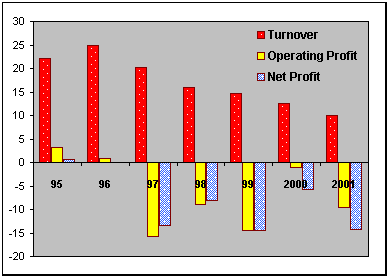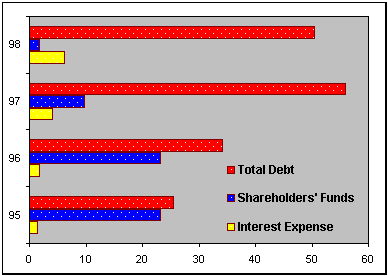|
Listed on the 2nd Board of the KLSE in Jan 1995, Nauticalink was a provider of ferry services in selected regions, covering Kuala Kedah, Kuala Perlis, Pulau Pinang, Langkawi, Lumut, Satun in Thailand and Belawan in Indonesia with a fleet of 10 ferries. With its wholly owned subsidiary, Kuala Perlis-Langkawi Ferry Service S/B (KPLFS), being the market leader for the Kuala Perlis-Langkawi route, Nauticalink had an established presence in the industry. It also operated a mini dry-dock in Kuala Kedah. However, the group's performance has been dismal, posting lowly profits during the initial 2 years of 1995 and 1996, followed by 5 consecutive years of losses - see figure 1. Its shareholders' funds of RM23.1 mln in 1995 were wiped out and by 2001, swung to a deficit of RM32.8 mln. With a seemingly dominant market position in a lucrative ferry route, what were the reasons for the poor performance?

Figure 1 : Financial Performance of Nauticalink (RM mln)
a) Lousy Economics, Poor Management
Unprofitable Core Business
The main business of Nauticalink was the ferrying of passengers, centred on the Pulau Langkawi-Mainland route. It is a competitive business with low barriers to entry and the government controls increases in its fares. Given these factors, in order to achieve satisfactory returns, Nauticalink has to manage its operations and costs efficiently. Unfortunately, Nauticalink could not achieve these.
Although it received government approval to raise its fares in 1996 and sales rose, Nauticalink suffered a plunge in profits as they plummeted 72.6% to RM0.8 mln from RM3.1 mln in 1995. Management cited the high cost of repair and maintenance, increased borrowings and overheads as the main culprits for the poor performance. The factors giving rise to a reversal in fortunes so soon after its listing imply that Nauticalink was probably postponing key repairs and maintenance prior to its listing. Nevertheless, it marked the start of decline for its ferry operations.
After 1997, the ferry division succumbed to 5 consecutive years of losses (see figure 1) and did not recover. A reason for this reversal in fortunes was the group's inability to compete with its competitors. The increase in the number of ferry operators from 3 to 8 in Langkawi affected Nauticalink badly. Compounded by a fall in tourist arrivals, the ferry operation was fighting a losing battle.
8 months after its listing, 4 directors including its Chairman resigned while their replacements came on board in Jan 1996. The only remaining directors were its major shareholder, Ooi Kooi Bee (with a 35% stake) and his son, Ooi Cheng Choon. Upon their appointments, the new management team implemented various unrelated expansion plans for the group. These ominous signs should have already raised alarms. Even before the 1997 recession, Nauticalink was already showing that an industry with poor economics combined with poor management was a recipe for disaster.
b) Expansion and Diversification
Wide Ranging Expansion
Realising that its ferry business was not lucrative, Nauticalink embarked on a strategy that worsened the situation rather than improve it. As part of its expansion, Nauticalink acquired the entire interest in Asia Slipway & Engineering S/B (ASE) for RM2.4 mln cash. ASE operates a mini dry-dock in Kuala Kedah, focusing on marine repairs and maintenance. With this purchase, the management planned to venture into the shipbuilding industry by building small marine vessels for the Malaysian government.
In 1996, Nauticalink entered into an agreement with MWE Holdings, which granted the group the right to acquire 49% of Diamond Head International Holdings Ltd for US$3.3 mln. This would have paved the group's entry into the gaming business but the deal was mutually aborted soon after.
In Apr 1997, its subsidiary, Popmal S/B, entered into an agreement for the right to develop 100 `POPEYES' franchised restaurants in Malaysia and Singapore. A US$500,000 territorial fee would be charged for the development rights. The group subsequently increased its investment in Popmal S/B with an additional RM800,000 cash.
Via its subsidiary, Cekapilih S/B, the group expanded into the shipping industry by providing vessel charter service to Petronas Dagangan for the shipment of clean petroleum from Malacca to Sibu. The group subsequently purchased a clean petroleum carrier from Korea for RM12.6 mln cash.
c) Overstretched Financial Resources
Financial Strain From Expansions
Nauticalink was also financing its expansion with more borrowings. As a result, the rapid and capital-intensive expansion caused further strains on an already burdened balance sheet. For instance, Nauticalink borrowed RM26.3 mln during the 1996-97 period, mainly to finance its RM27.6 mln purchase of fixed assets. The group also invested a total of RM4.0 mln in its various subsidiaries from 1995 to 1998. It doubled its debt from RM25.5 mln in 1995 to RM50.5 mln in 1998. The gearing ratio surged to an extremely high 29.7 times. With sales of only RM16.0 mln and interest expense of RM6.2 mln in 1998, one would have seriously doubted the group's ability to service its mounting debts and maintain its profitability.

Figure 2 : Debt Obligations and Capital Structure (RM mln)
d) Unsuccessful Business Ventures
Failure of Expansion
Barring the mini dry-dock business, Nauticalink's other ventures have proven unprofitable. The fast food division has not registered a profit since its inception (see table 1). Subsequently in 1999, the group closed this division, writing off intangible assets and deferred expenditure totalling RM1.3 mln.

Table 1 : Segmental Reporting (RM mln)
Closure of Ferry Operations, Exit of Major Shareholder
In 1998, due to its mounting debt obligations, negative cash flows and a string of losses, Nauticalink appointed a corporate adviser to formulate a restructuring scheme to enable the group to continue its operations. It wrote down RM11.7 mln of its investments and commenced the disposal of its ferries to repay its huge borrowings. Its majority shareholder, Ooi Kooi Bee, resigned as director in May 1999 and he subsequently sold down his 21% stake to 8.46%. Under such a gloomy backdrop, the group, not surprisingly, terminated its ferry operations in mid-2000. By Feb 2001, Nauticalink, without a profitable core operation and shareholders' funds in deficit of RM18.5 mln, was deemed an affected listed issuer under the PN4 category.
|



